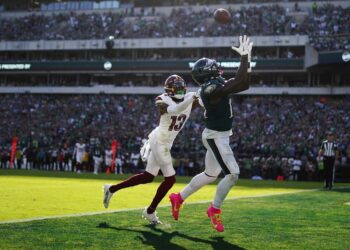The Boston Red Sox are five years into an organizational rebuild that started when they traded Markus Lynn Betts to the Dodgers for literal pennies on the dollar before the 2020 season. Whether the organization intended to start a rebuild or not at the time of the trade, the results of the last five seasons make it crystal clear that’s exactly what happened. Their record in the previous five seasons is as follows: 24-36 (COVID year), 92-70 (ALCS appearance), 78-84 (last place), 78-84 (last place), and a perfectly mediocre 81-18 (third place) in 2024. Outside of the 2020 COVID season, during which the organization actively tried to tank, they never truly bottomed out and even had a playoff run as a wild-card team in 2021. Still, for the Boston Red Sox, 353-355 (394-416 if a full season was played in 2020 and the Red Sox maintained their 60-game winning percentage of .400) over a five-year span is as close to bottoming out as things get in Boston.
If it can be debated whether the Red Sox brass intended to start a rebuild in 2020 or not, there’s no debating that the organization fully embraced it after the dreadful COVID year. Instead of using the “financial flexibility” that the Mookie trade supposedly gave them to bring in Major League-ready talent, the organization instead shifted to the “draft and develop” model that middle and small-market teams, like the Rays, rely on. They all but stopped making any meaningful free-agent signings and instead opted for short-term reclamation projects like Garret Richards and Martin Perez in the rotation and Kike Hernandez and Rob Refsnyder in their lineup. They did just enough at the Major League level to stick around on the fringe of Wild Card contention through the summer while focusing the majority of their resources on their farm system – and to their credit, while the Major League product has been lackluster recently, their farm system has been working overtime.
There are no fewer than 1 million outlets that rank MLB prospects, but every one of them agrees that the Red Sox currently have three of the top ten prospects in baseball. How did they get here? Well, in 2021, armed with the 4th overall pick on the back of their 24-36 2020 campaign, the Sox picked high school shortstop Marcelo Mayer. In 2022 they selected high school outfielder Roman Anthony 79th overall, and in 2023 they picked college infielder Kristan Campbell in the 4th round of the draft. Mayer, Anthony, and Campbell now rank as the 7th, 3rd, and 10th best prospects in all of baseball according to MLB.com. Beyond the big three, the Red Sox farm system is far and away the best in the game according to other baseball execs.
John Henry and his assorted mouthpieces have been telling Red Sox fans to be patient with the Major League club (and ownership’s financial commitment) until the “kids” are ready to contribute to the big club, but with the kids knocking at the Major League door, what’s next for the team, and what should fans realistically expect in 2025 and beyond? And when will the Red Sox return to their free-spending ways and reel in a big fish in free agency?
Let’s tackle the second part of that question first. This offseason is the second one in a row during which a high-ranking member of the baseball ops department has pledged, publically, to spend money and bring in some proven Major League talent. Last year, after Tom Werner’s “full throttle” comment, the organization walked back their commitment to spending and instead filled out the roster with misfits and castoffs from other organizations while, again, preaching patience. The 2024 season was ultimately a step in the right direction and saw three home-grown Red Sox selected to the all-star team in Devers, Houck, and ASG MVP Jarren Duran. Couple those all-stars with the strong seasons from Brayan Bello (1.5 WAR) on the bump and Ceddanne Rafaela (2.5 WAR) all over the diamond and you can see a core emerging with reinforcements on the way.
Conventional wisdom dictates that this offseason would be the time to start spending, and with a strong if not spectacular crop of free-agent pitchers available this winter, it seemed inevitable that the Sox would land either Max Fried or Corbin Burnes to lead their rotation. After all, it’s no secret that pitching is a gigantic need for the Sox, and despite their robust farm system, there aren’t any young arms that are close to major league-ready in Worcester or Portland.
Not Quite.
The Red Sox pretended to be in Juan Soto, who was NEVER going to sign here, over the first 45 days of the offseason, but on the same day Soto signed with the Mets, the Sox completed a deal for White Sox lefty Garrett Crochet by giving up the 25th ranked prospect in baseball in catcher Kyle Teel. In a vacuum, Crochet should be the ace the Red Sox need, and he may very well be, but 2024 was his first year as a starter and he pitched with a significant innings restriction, not going more than 4 innings in any start over the final three months of the season. Moreover, Crochet is still on his rookie deal and is only 2 seasons away from free agency, so barring a long-term deal on a quasi-unproven prospect, the Red Sox have only kicked the ace can down the road. It’s a good deal, but hardly the kind of big-money, proven free agent signing this team so desperately needs.
Boston also added former Dodger Walker Buehler on a 1-year $20M deal just after Christmas in another “bandaid” deal that provides no long-term organizational stability. Buehler is coming off a second Tommy John surgery in 2023 and only took the 1-year deal after being unable to find a longer-term deal on the open market. If he pitches well in 2025, he’ll get paid next offseason, and if the recent past has been any indication of future spending, the Red Sox won’t be willing to pay what it’ll take to retain his services.
As of late January, the Red Sox 2025 rotation is as follows. Garrett Crochet, Tanner Houck, Walker Buehler, Brayan Bello, and probably Kutter Crawford. A major improvement, on paper, from the dumpster fire we’ve become accustomed to, but there are question marks around health and the ability to hold up over a long season for every member of the rotation. Had the Red Sox added Max Fried (who went to the Yankees) or Corbin Burnes (Diamondbacks) to lead this rotation in addition to trading for Crochet, this rotation would feel a lot more…stable. Once again, the front office was reluctant to do what it took to lure in a big free agent to solidify their rotation despite two front-line pitchers being available and, one would think, plenty of money to spend after a few years of reduced spending. Frustrating.
Offensively, the 2024 Red Sox were 9th in the league in runs scored, so there are fewer questions about their lineup outside of their reliance on lefthanded hitters. Conventional wisdom dictates that the team should add an impact right-handed bat to this lineup that, as of now, will have only 3 right-handed hitters (Story, Wong, and Rafaela), with Story being the only one of the group that can even moonlight as an impact bat. There is talk of trading for 34-year-old Nolan Arenado who, in addition to being a legit right-handed bat, would bring gold glove defense to third base. That move, however, would cost the Red Sox about $20M a year for the next three years and would force the team to either DH Devers daily or move Raffy to first base and flip Casas for another piece. I don’t hate this idea but the Red Sox would be selling extremely low on Casas after he missed the majority of the 2024 season, and any team trying to put a deal together with the Sox would know they have to trade Casas if Arenado was on the roster. The bright side of any Arenado deal is that the Cardinals are more interested in shedding salary than they are in acquiring high-end talent in a deal, so the prospect price would not be significant. Overall this is not a perfect scenario, but absolutely one they should explore.
Option #2 for getting an impact right-handed bat is to sign Alex Bregman and have him play 2nd base in a move that’d be similar to the Trevor Story deal the team made in 2022. Bregman is not the thumper he was 5 years ago, but he’s an above-average right-handed bat who would figure to take advantage of the Green Monster regularly. The problem with this deal, though, is Bregman’s asking price. He’ll be 31 on opening day and has seen his WAR drop each of the last five seasons from 8.9 in 2019 to a still respectable 4.1in 2024, so signing him to a 6+ year deal for somewhere around $200M is something that should give any interested team a bit of reservation. Much like the proposed Arenado deal detailed above, it wouldn’t come without risk, but if the Red Sox are as serious about contending as they are willfully leading everyone on to be, they need to find a way to insert a high-quality right-handed bat into this lineup and Bregman is one of the few options still available.
What will the Red Sox do? Probably nothing. There’s an old saying that goes something like this: Don’t piss on my leg and tell me it’s raining. Despite the Red Sox front office claiming they are ready to spend money each of the last two seasons, it doesn’t feel like they are. Sure, if Fried or Burns was willing to sign a 3-year, $90m deal, the Red Sox would have been all over it, but this team has shown time and time again that they are unwilling/uncomfortable signing high-priced free agents, and I don’t think this will change any time soon. They’ll continue to be “in” on all of the big fish but won’t do what’s necessary to actually land them. This roster is loaded with young talent and is poised to make some noise. They just need some help from the front office.
My ultimate question to the Red Sox organization is this. If not now, when?




